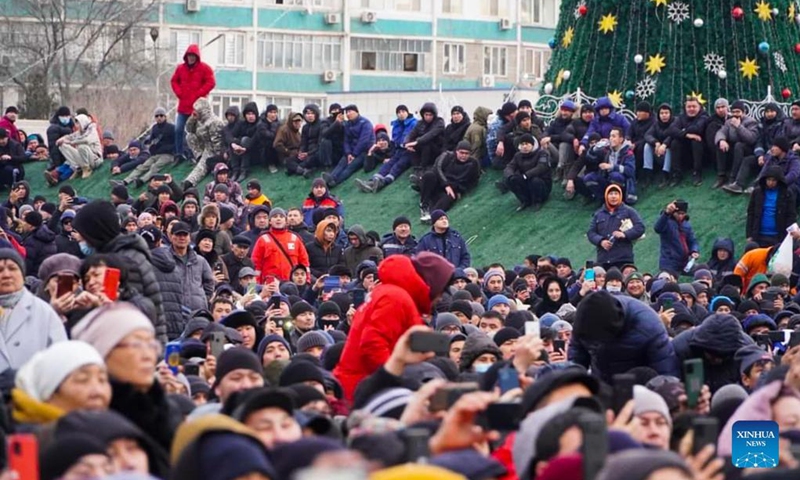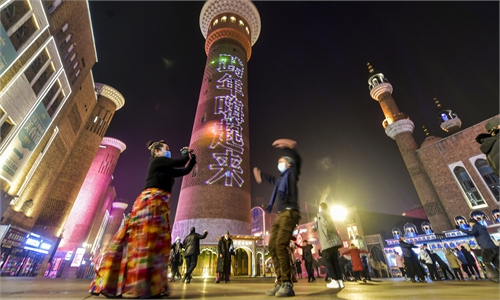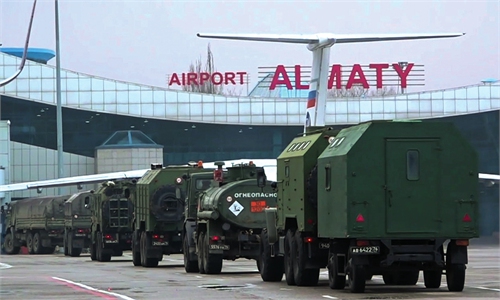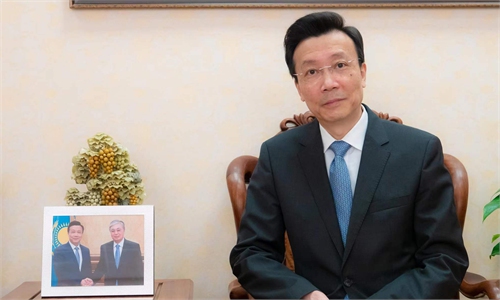
People rally to protest against the price rise of liquefied petroleum gas in Aktau in the Mangystau province, Kazakhstan, Jan. 4, 2022. Kazakh President Kassym-Jomart Tokayev declared a state of emergency in the Kazakh city of Almaty and the Mangystau Region in southwest Kazakhstan on Wednesday. The mounting unrest prompted the Kazakh government to seek help from the Collective Security Treaty Organization, which has decided to deploy peacekeeping forces to Kazakhstan.(Photo: Xinhua)
On Tuesday, President of Kazakhstan Kassym-Jomart Tokayev made it clear that the worst of the trouble was perpetrated as part of an elaborate conspiracy of yet-unspecified international terrorist groups. Thanks to the swift anti-terrorist operation, constitutional order has been restored in Kazakhstan.While the world was still enjoying New Year celebrations, no one expected to see tens of thousands of organized gangsters plunge Kazakhstan, the wealthiest Central Asian country, into nationwide unrest overnight. Indeed, the escalation of hostilities showed traces of a premeditated, organized anti-government movement. It would be impossible for workers of a local factory in grievance of the rising LNG price to professionally mobilize and even pay thousands of people to protest, let alone destroy crucial facilities with arms, burn down government buildings, shoot police with rifles, and occupy the Almaty Airport and control airplanes. A Kazakhstan news program showed that a Kyrgyz protester confessed to having taken $200 and a plane ticket to travel to Kazakhstan to protest.
Then how was the public anger over economic plight turned into a political movement and how did a peaceful demonstration escalate into violence and riots? It is unusual that the tension did not cool down even when the Kazakh government had agreed to halt the LNG price hike and released people detained at the Aktau rally. It turned out that the demonstrators reached out for a yard after having taken an inch: They asked for a direct dialogue with the president and shouted political slogans like "Nazarbayev leave the country."
For anyone who follows international affairs, there is a sense of déjà vu: Scenes of violence in Kazakhstan easily reminded people of the "color revolutions" in regional countries. Just eight years ago in Ukraine, hundreds of thousands of rioters devastated central Kiev with violence and bloodshed. US and European countries, while inciting the rebels with propaganda and promises, threatened the Yanukovych government with sanctions until a pro-Western regime was inaugurated. In Kyrgyzstan, upheaval has become an unwelcome visitor ever since the Western-supported Tulip Revolution.
In Kazakhstan, professional inciters were hired to maneuver public sentiments and turn originally peaceful protesters into terrorists, who would then be provided with food, supplies and funds to confront the police and occupy key infrastructure. Mukhtar Ablyazov, the dissident leader in exile, rode the tide to invite the Western countries to enter the fray, while social media posts encouraged people to "fight back, create resistance groups and organize attacks."
Since the very beginning, there has been much suspicion and speculation about foreign forces getting involved, or even manipulating behind the scenes. The presence and influence of Western countries and foreign nongovernmental organizations (NGOs) in Kazakhstan might give some clues.
For a long time, the looming shadow of the US has been cast in every corner of Kazakhstan. It is by no means a coincidence that the US seemed to have predicted the situation unfolding and escalating. Half a month before the riots broke out, the US Embassy in Kazakhstan warned that demonstrations in Nur-Sultan and Almaty could escalate into violence. A batch of NGOs sponsored by the US, smelling a storm, swiftly retreated from the country.
The International Center for Not-for-Profit Law (ICNL) estimates there are 38,000 active NGOs in Kazakhstan while the majority of them ̶ some say around 20,000 ̶ are funded by US and European countries by way of grants and donations, including the US Agency for International Development (USAID), the National Endowment for Democracy (NED), and Freedom House.
Among them, the NED alone spent more than $1 million to support the so-called democratic processes and human rights movements in Kazakhstan in 2020, according to data published by the organization. The funds were used to increase the youth's engagement in social and political processes, support the allegedly independent mass media, and protect civil society in Kazakhstan.
Executive Vice President of Eurasia Group Earl Rasmussen told the hard truth recently: Generous funding from international NGOs and the US government has played a key role in the social unrest that has gripped Kazakhstan.
The author is a commentator on international affairs, writing regularly for Global Times, China Daily etc. He can be reached at xinping604@gmail.com.



